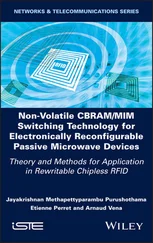Joel P. Dunsmore - Handbook of Microwave Component Measurements
Здесь есть возможность читать онлайн «Joel P. Dunsmore - Handbook of Microwave Component Measurements» — ознакомительный отрывок электронной книги совершенно бесплатно, а после прочтения отрывка купить полную версию. В некоторых случаях можно слушать аудио, скачать через торрент в формате fb2 и присутствует краткое содержание. Жанр: unrecognised, на английском языке. Описание произведения, (предисловие) а так же отзывы посетителей доступны на портале библиотеки ЛибКат.
- Название:Handbook of Microwave Component Measurements
- Автор:
- Жанр:
- Год:неизвестен
- ISBN:нет данных
- Рейтинг книги:5 / 5. Голосов: 1
-
Избранное:Добавить в избранное
- Отзывы:
-
Ваша оценка:
- 100
- 1
- 2
- 3
- 4
- 5
Handbook of Microwave Component Measurements: краткое содержание, описание и аннотация
Предлагаем к чтению аннотацию, описание, краткое содержание или предисловие (зависит от того, что написал сам автор книги «Handbook of Microwave Component Measurements»). Если вы не нашли необходимую информацию о книге — напишите в комментариях, мы постараемся отыскать её.
Handbook of Microwave Component Measurements — читать онлайн ознакомительный отрывок
Ниже представлен текст книги, разбитый по страницам. Система сохранения места последней прочитанной страницы, позволяет с удобством читать онлайн бесплатно книгу «Handbook of Microwave Component Measurements», без необходимости каждый раз заново искать на чём Вы остановились. Поставьте закладку, и сможете в любой момент перейти на страницу, на которой закончили чтение.
Интервал:
Закладка:
1.14.2 Amplifiers: System, Low‐Noise, High Power
1.14.2.1 System Amplifiers
System amplifiers are simply gain blocks used to boost signal levels in a system, while providing reverse isolation. They can have higher noise figures than LNAs as they are used in signal paths where the signal is well above the noise floor. They often follow an LNA stage, frequently after some pre‐filtering. They are also often used in the frequency converters as a local oscillator (LO) amplifier to isolate the RF signal from leaking out the LO port, or as an isolation amplifier to prevent LO leakage out the RF port. These tend to be broad band amplifiers, with good input and output match, emulating an idealized gain block. The important figures of merit for such amplifiers are gain (S21), input and output match (S11, S22), and isolation (S12). Occasionally, directivity of an amplifier is defined as isolation (a positive number in dB) minus the gain (in dB), or S12/S21. It is a measure of the effects of a load apparent at the input of the amplifier, or how the output impedance is affected by the source impedance (Mini‐circuits n.d.) and is important in cases where other system components have a poor or unstable match. Since these amplifiers have wide bandwidths, it is important that they have good stability as they can have a variety of load impedances applied. Other figures of merit for system amplifiers can include gain flatness (deviation of the gain from nominal value), 1 dB compression point (the power at which the gain drops by 1 dB), harmonic distortion, and two‐tone third‐order IM, sometimes expressed as third‐order intercept point (see Section 1.3).
1.14.2.2 Low‐Noise Amplifiers
Low‐noise amplifiers are found in the front end of communications systems and are particularly designed to provide signal gain without a lot of added noise power. The key figure of merit is noise figure, along with gain. But, in a system sense, the noise parameters (see Section 1.3) are quite important as they describe the way in which the noise figure changes with source impedance. LNAs are used in low‐power applications, and their 1 dB compression point is not a key spec; however, distortion can still be a limiting factor in their use, so a common specification is the input referred intercept point. A key trade‐off made in LNAs is between lowest noise figure and good input match. The source impedance where the LNA provides the lowest noise may not be the same as the system impedance, so a key design task for LNAs is to optimize this trade‐off.
1.14.2.3 Power Amplifiers
Many of the figures of merit for power amplifiers are the same as system and LNAs, but with an emphasis on power handling. In addition, the efficiency of the amplifier is one of the key specifications that one finds primarily with power amplifiers, implying that the DC drive voltage and current must also be characterized. Because power amplifiers are often used with pulsed RF stimulus, the pulse characteristics, such as pulse profile including pulse amplitude and phase droop, are key parameters.
Power amplifiers are often driven into a non‐linear region, so the common linear S‐parameters may not apply well to predict matching. Therefore, load‐pull characterization is often performed on power amplifiers. Gain compression and output‐referred intercept point are common for power amplifiers. Some amplifier designs such as traveling‐wave‐tube amplifiers (TWT) have a characteristic that causes the output power to reach a maximum and then decrease with increasing drive power, and the point of maximum power is called saturation . Gain at rated output power is another form of a compression measurement where rather than specifying a power for which the gain is reduced by 1 dB, it specifies a fixed output power at which the gain is measured.
Power amplifiers are often specified for their distortion characteristics including IMD and harmonic content. In the case of modulated drive signals, other related figures of merit are ACPR and adjacent channel power level (ACPL). A figure of merit that combines many others is EVM, which is influenced by a combination of compression, flatness, and inter‐modulation distortion among other effects.
1.14.3 Mixers and Frequency Converters
Another major class of components is mixers and frequency converters. Mixers convert an RF signal to an IF frequency (aka down‐converters) or IF frequencies to RF (up‐converters) through the use of a third signal, known as the local oscillator (LO). Typically, the output or input that is lower in frequency is called the IF (for intermediate frequency ). The LO provided to the mixer drives some non‐linear aspect of the circuit, typically diodes or transistors that are switched on and off at the LO rate. Using the second definition, frequency converters and mixers would not be considered linear. In fact, in their normal operation, they are linear (under the first definition) with respect the desired information signal, and ideally the frequency conversion does not change the linearity of the input/output transfer function.
The input is transferred to the output through this time‐varying conduction, and the output signal includes the sum and difference of the input and the LO. Mixers tend to be fundamental building blocks that are combined with filters and amplifiers and sometimes other mixers to form frequency converters. In practice, frequency converters are typically filtered at the input to prevent unwanted signals from mixing with the LO and creating a signal in the output band, and they are typically filtered at the output to eliminate one of the plus or minus products of the mixing process. Some converters, known as image reject mixers , have circuitry that suppresses the unwanted product, sometimes called the sideband , without filtering. These are typically created by two mixers driven with RF and LO signals phased such that the output signals of the desired sideband are in phase and added together to produce a higher output, and the undesired sideband is out of phase; thus they cancel and produce a smaller output. Monolithic microwave integrated circuits (MMICs) sometimes blur the line between converters and mixers as they may contain several amplifier and mixing stages, but they typically don't contain filtering.
Mixers have fundamental parameters that include conversion loss (or gain in the case of MMICs with amplifiers), isolation (of which there are 12 varieties, to be discussed in Chapter 7), compression level, noise figure (which for passive mixers is typically just the conversion loss), input and output match, and most of the other parameters found for amplifiers.
Mixers are sometimes referred to as passive mixers or active mixers. Passive mixers don't contain amplification circuits, are typically constructed of diodes (with a ring or star configuration being most common), and have baluns in some paths to provide improved isolation and reduced higher‐order products. Higher‐order mixing products, also called spurious mixing products or spurs , refer to signals other than the simple sum and difference of the input and LO frequencies. They are often referred to by the order of harmonic related to creating them; for example, a 2:1 spur is created at the frequency of two times the LO plus and minus one times the input. The level of the mixer spurious products, which are sometimes called mixer intermod products (even though the two tones are not applied to the input), change with respect to the RF drive signal at the rate of the order of the RF portion of the spur. For example, a 2:1 spur will increase 1 dB in power for each dB in power the RF signal increases. However, since the LO is creating the non‐linearity in the mixer, as well as the spurious signal, it is difficult to predict how the spurious power will change with respect to LO power. In many cases, driving the LO power higher produces a higher spurious signal, as the relative magnitude of the RF signal to the LO power is reduced; in other cases, the transfer impedance of the non‐linear element becomes more consistent across the RF drive level. The spurious higher‐order products of a mixer are sometimes defined as a spur table, which shows the dBc values of higher‐order products relative to the desired output. Chapter 7has more details on measuring these behaviors.
Читать дальшеИнтервал:
Закладка:
Похожие книги на «Handbook of Microwave Component Measurements»
Представляем Вашему вниманию похожие книги на «Handbook of Microwave Component Measurements» списком для выбора. Мы отобрали схожую по названию и смыслу литературу в надежде предоставить читателям больше вариантов отыскать новые, интересные, ещё непрочитанные произведения.
Обсуждение, отзывы о книге «Handbook of Microwave Component Measurements» и просто собственные мнения читателей. Оставьте ваши комментарии, напишите, что Вы думаете о произведении, его смысле или главных героях. Укажите что конкретно понравилось, а что нет, и почему Вы так считаете.












